Spawning & Manipulating Assets¶
This section describes spawn asset in detail, concepts of filtering, how we name
things, how Convert To Linked and Convert To Editable can be used in your scenes to maximize
efficiency and asset related features that we ship in botaniq. Some sections like
filters are applicable to scatter.
Spawn Asset¶
Spawn Asset button can be used to spawn a single asset. The model will always spawn at the current
3D cursor location.
Spawn Asset Dialog¶

Asset to be spawnedis the main part of the user interface. It is a preview image representing the asset that will be spawned after clicking theOKbutton. If you want to spawn another asset click on the image and a list with all assets fitting your filter will appear.Common nameis often rendered into the preview. Useful when you are not familiar with the latin names. Those names are supported in the search filter.- In most preview images there is a
measureincluded. You can look at the measure to get an idea of approximate size of the asset before spawning it. One step is equal to 1m (3.28ft), small assets have the measure downscaled so one step is 10cm (3.9in). Latin nameis displayed under the preview and comes handy for landscape architecture. Latin name is more specific than common name and it can help you to choose the right model for a given area.Use botaniq collectioncheckbox. When checked the asset will be placed in a category collection under abotaniqcollection. If the collections do not exist they will be created. This makes all of botaniq content end up in one place for your convinience.Make editablecheckbox. When checked the asset is appended to the scene, otherwise, linked instances will be created. We recommend having this option disabled to save memory. It is possible to make assets editable afterwards. For more information read Convert To Editable section.
Filters¶
Spawn asset and scatter list of models can be filtered by seasons and by a text input provided from user.
Seasons¶
To filter assets by seasons tick the desired season boxes. Assets can also be displayed in multiple seasons. For example, some evergreen shrubs will be the same in spring, summer and autumn, so they will appear in any of the seasons.
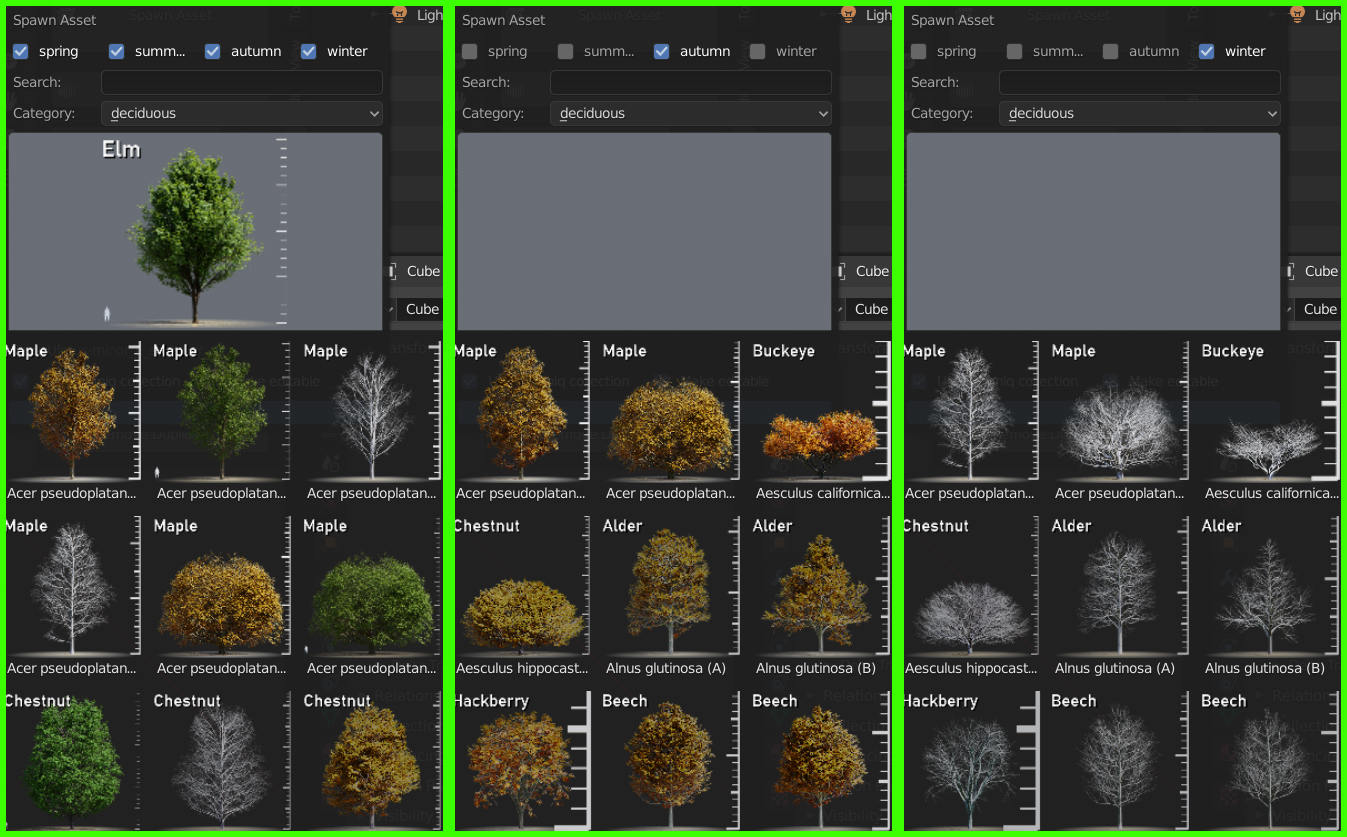
All models don't have all seasons
Some assets don't contain all of the seasons. This is reflected from real life. It doesn't make sense to have cacti in winter.
Under the hood
Notice that the season is part of the name of the asset. If the name is changed, then some features like randomize variant may not work correctly.
Search¶
Use this field to search for a model by keyword. For example, if you write the keyword maple only
maple trees will show up in search. This is a quick way of getting the asset if you know what you
are looking for and don’t want to scroll through all assets.
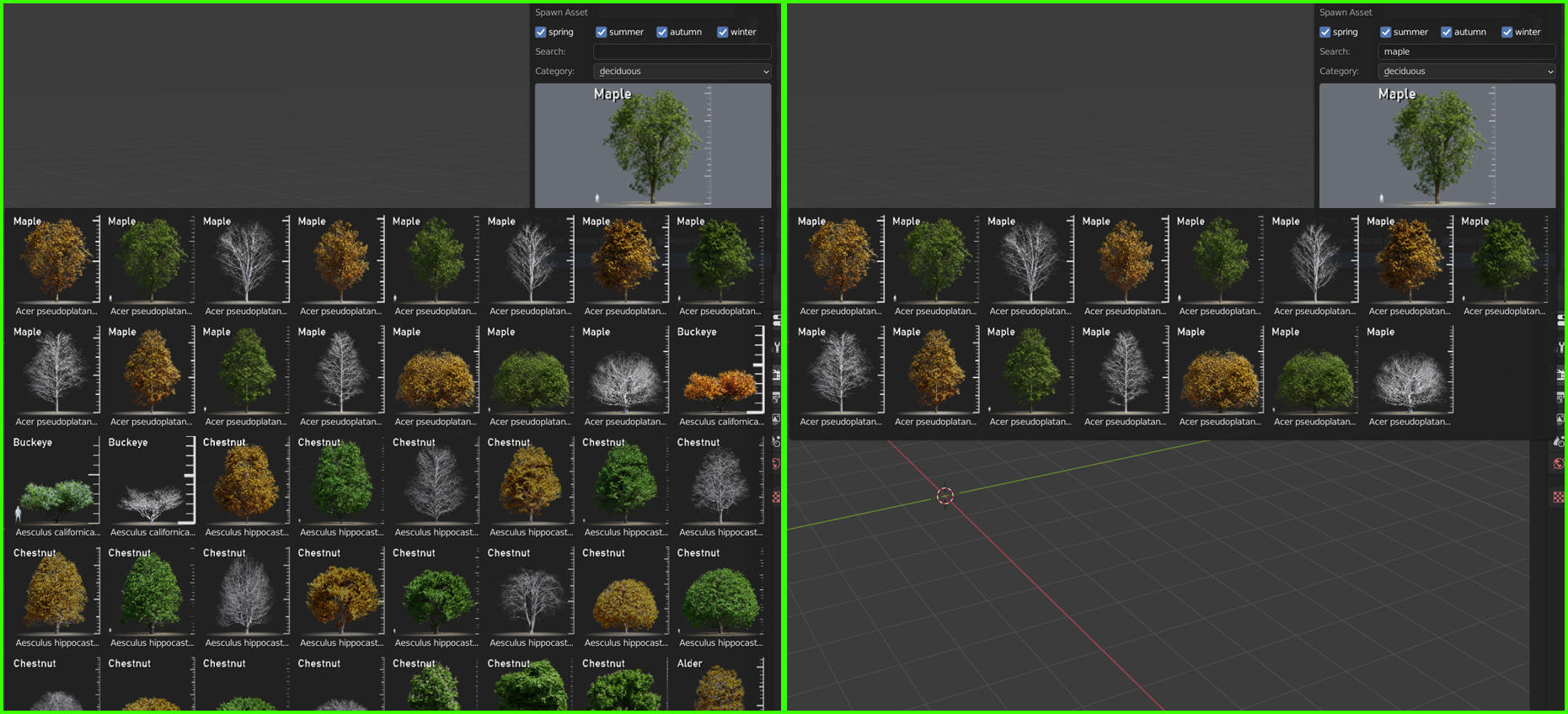
Multiple filters
The category and the seasonal filter are still active next to search filter. If you search for
tree that was already filtered by other filters it won't show up. For example if you search for
maple in the tropical category there will be no matching assets.
Multiple keywords
Search filters can take multiple words split by Space for more complex queries. You can use
search filter maple chestnut alder and all maples, chestnuts and alder trees will be
displayed.
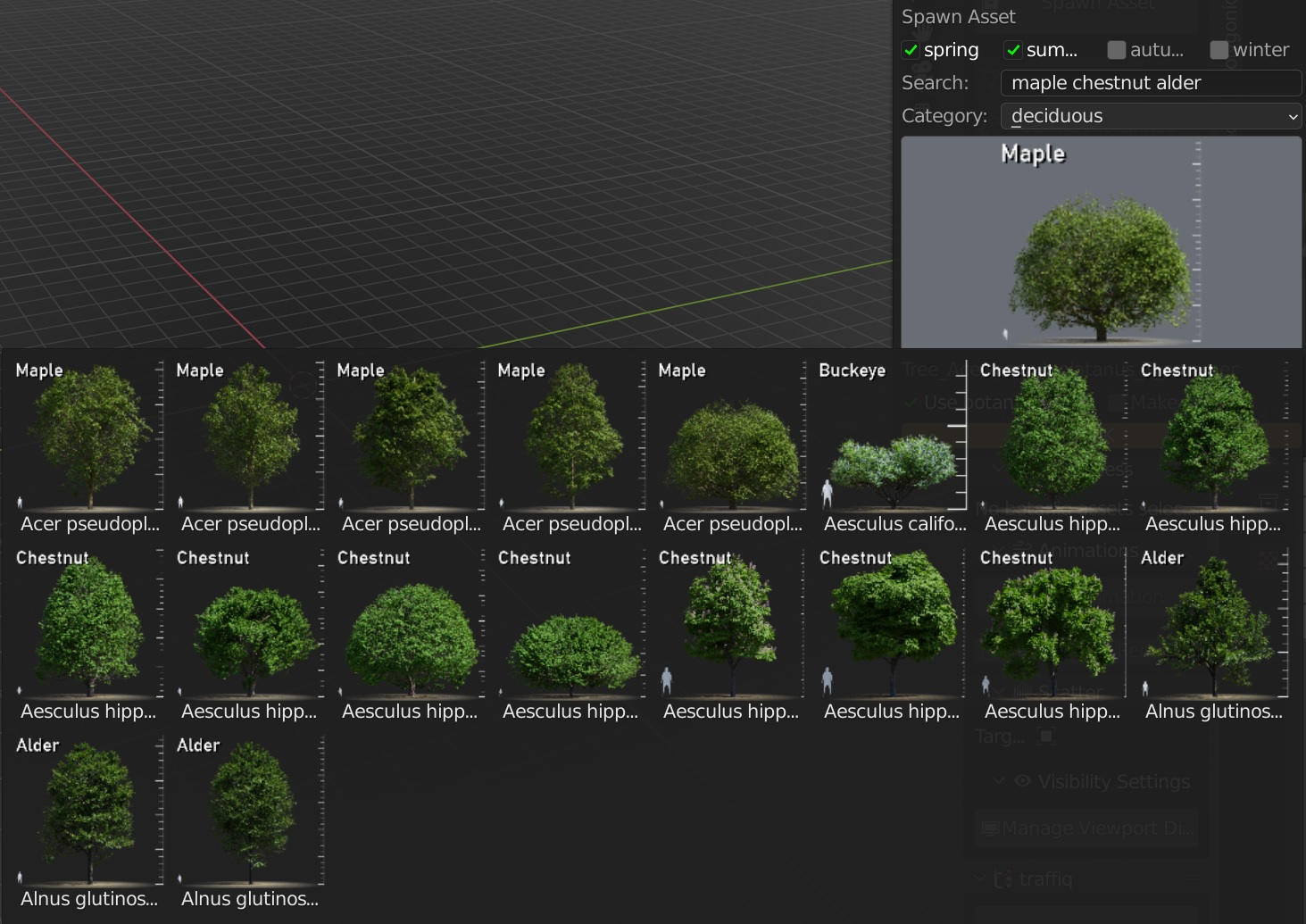
Category¶
botaniq assets are sorted into multiple categories according to their type. Only assets from
selected categories will appear in the assets to be spawned. All other filters apply after this one.
You won't find deciduous trees using search filter when in a coniferous category.
Editable & Linked Assets¶
Objects in botaniq can be in two states. Either linked or editable. Linked
objects save memory and are easily updatable. On the other hand editable objects can be customized
to your liking. botaniq assets should get nice render results out of the box, thus
linked variant should be used in most of use cases.
Optimization tip
We have a complete section that describes benefits of using linked assets on the advanced topics page.
Limitations of linked assets
Linked assets are limited in terms of customization. There are only a few attributes that we can feed into shaders. The amount of data will always be limited. We try to choose a commonly used customization and support that even on linked assets. Keep in mind that for bigger changes you will have to convert to editable.
Convert To Editable¶
This button converts selected objects to editable and makes them local to the scene. This way you
have complete control of the objects, you can change the mesh, textures, materials, apply custom
modifiers, animations, etc. On the flip side, this affects the performance of the scene so use this
function wisely.

Convert To Linked¶
This button converts selected objects back to their linked variants. Works only on polygoniq
assets because we know where we can locate the original variant. Doesn't work on particle systems.
Destructive operation
Converting to linked can be destructive. All local modifications to the asset will be
removed (mesh changes, materials changes, animations) and the default botaniq
asset is going to replace the existing one!
Asset Manipulation Features¶
botaniq is shipped with features that improve default blender workflow and are ready to use in the
panel at hand.
Random Transform¶
Each object in the selection will be randomly rotated and scaled with each click. Transform is manipulated only slightly so the object stays semi-vertical.

Quick forest
You can use small amount of trees with randomized transforms to create a illusion of diverse and non-repeating forest quickly.
Reset Transform¶
Each object in the selection will get its rotation set to (0, 0, 0) and scale to (1, 1, 1).
Randomize Variant¶
Replaces botaniq assets in selection by variants of the same model. Randomize variant preserves seasons - we won't replace your preciously designed autumn scene with a mix of summer and winter trees.
Nothing happens
Not all models have an existing variant within corresponding season. If the model has only variant A, randomize variant button won't do anything. The button may not do anything even if there are multiple variants of the same asset - try pressing multiple times, we include the selected asset into the random choice too.
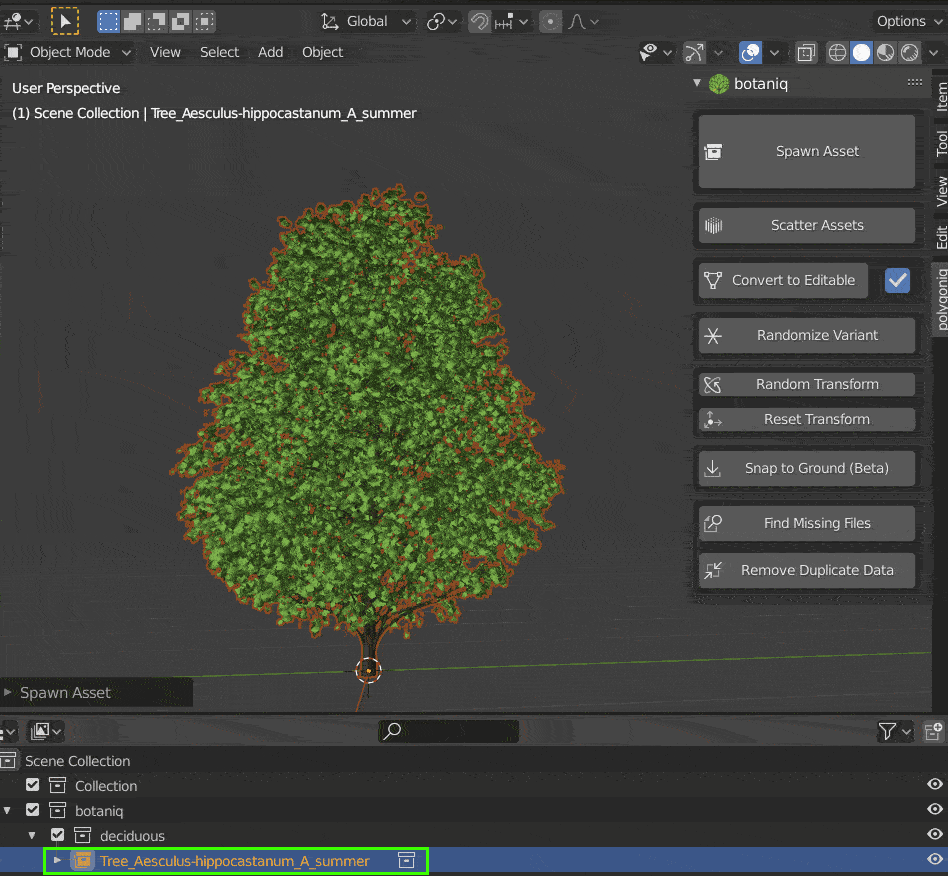
Snap To Ground¶
Snaps selected obejcts to the ground below. Works on all selected objects including non-botaniq assets.
Multiple ground objects
Make sure that there is another object under the selected one. If there are multiple objects below then the selected object should be snapped to the uppermost one.
Non-botaniq linked assets & bounding box
Snap to ground works also on linked assets. It is calculated using the bounding box, so make sure that origins are in correct place.
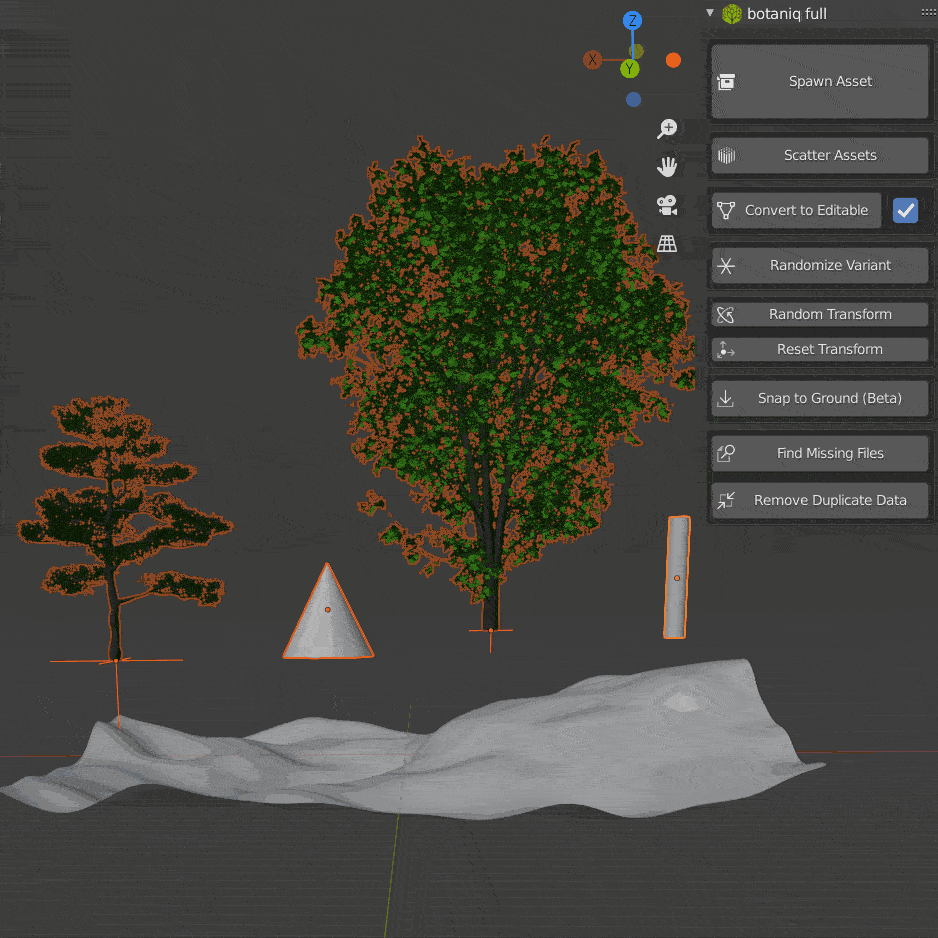
Brightness¶
Subpanel that allows customization of botaniq vegetation assets.
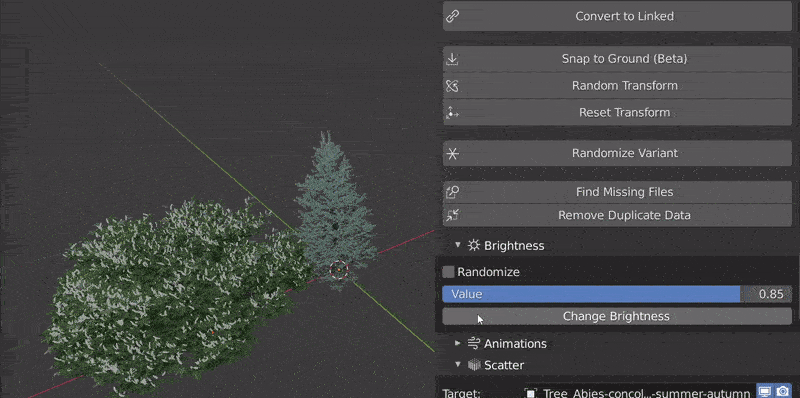
Randomizecheckbox. When checked in thenminimalandmaximalvalue is displayed and the resulting brightness value is chosen uniformly from the provided range.Valueto set the brightness to.Change Brightnessbutton. When clicked the brightness is set for all selected assets.
Object color usage
We use object color to change value on linked objects. Other addons may use the object color for different functionalities, so please keep that in mind.
Utilities¶
Following section describes utility features that can minimize the duplicates in your file or help you resolving issues.
Remove Duplicate Data¶
Having multiple editable assets can result in many duplicated materials, node groups or textures
that reference the same things. Duplicate data are indicated with the .001, .002, ... suffixes.
Remove Duplicate Data button merges all duplicate data into one datablock
(data deduplication). This applies to materials, node groups and textures.
Optimization tip
Having less materials, node groups and textures results in smaller .blend file sizes, saves
memory, bandwith and makes your scenes clean.
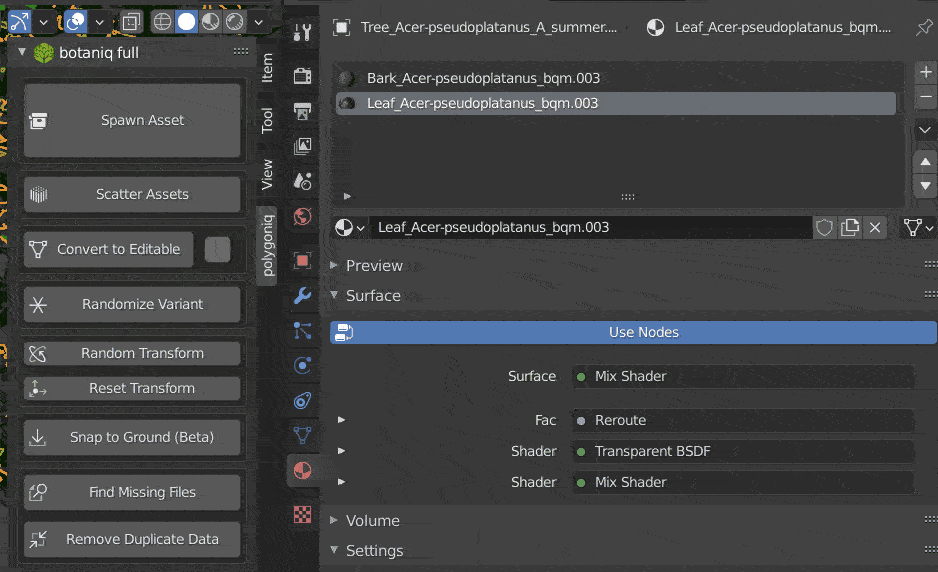
Automatic deduplication checkbox
If checkbox located next to the Convert To Editable button is checked in then data
deduplication is done automatically for each botaniq asset converted to editable.
Find Missing Files¶
Looks for missing files in the botaniq installation path you have set in preferences. Quick way to fix broken references to images, materials, collections or other botaniq related datablocks.
Missing models
If you are missing models (collection datablocks) you need to Save and Revert (reopen) the
.blend file in order to reload them back into the scene.
Missing Files can't fix everything
Find Missing Files can't solve everything. There are certain cases when it is neccessary to
respawn the asset or fix the paths manually (advanced). This can mostly happen when there was
a major update to the naming of the assets, textures or related. But firstly please make sure
that the botaniq installation is valid.